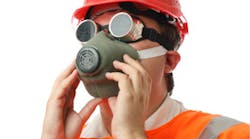Asbestos is the generic name given to a group of naturally occurring, fibrous minerals with high tensile strength, flexibility, and resistance to heat, chemicals, and electricity. Although exposure to asbestos has been shown to cause numerous respiratory health conditions — including asbestosis, lung cancer, and mesothelioma — the mineral is still used in construction. Furthermore, any building constructed prior to 1980 can contain asbestos in the insulation, fireproofing, floors, walls, or roof.
Tradesmen in the electrical industry are among the most at risk for breathing in toxic asbestos fibers while on the job. It is estimated that 10,000 people will die each year for the next 10 years due to asbestos exposure. Even more alarming is the fact that the symptoms of asbestos-related diseases generally do not appear for 20 or more years after initial exposure.
The following actions are recommended to reduce the risk of exposure to asbestos:
-
According to OSHA and the EPA, workers who are required to disturb asbestos (loosen the fibers) must receive special training. Employers must pay for training, which takes one to four days. In some cases, additional training may be required each year.
-
As defined by OSHA, there must be a “competent person” wherever asbestos work occurs. The competent person should know the requirements for personal protection and inspect the job regularly.
-
Workers who disturb or remove asbestos must wear at least a half-face respirator with N-, R-, or P-100 (HEPA) cartridges. Even if workers wear a respirator, they should try to reduce the asbestos in the air. OSHA and the EPA recommend keeping the asbestos wet. Vacuum the dust using special HEPA vacuums, which can capture very small fibers. Immediately collect and close all waste in special bags to hold asbestos.
-
Don't eat, drink, or smoke in an asbestos work area. In addition, workers should clean their hands and face before they eat, drink, or smoke.
-
Leave work clothes and shoes at work and wash them at work, or use disposable work clothes. Family members of construction workers can be exposed to asbestos that may be present on the worker's clothing. In addition, OSHA says that workers who perform asbestos abatement must shower before leaving work.
-
Workers who have been exposed or believe they have been exposed to asbestos on the job should consult a doctor who is knowledgeable about work-related diseases and/or lung diseases.
Source: The Center to Protect Workers Rights (CPWR)




